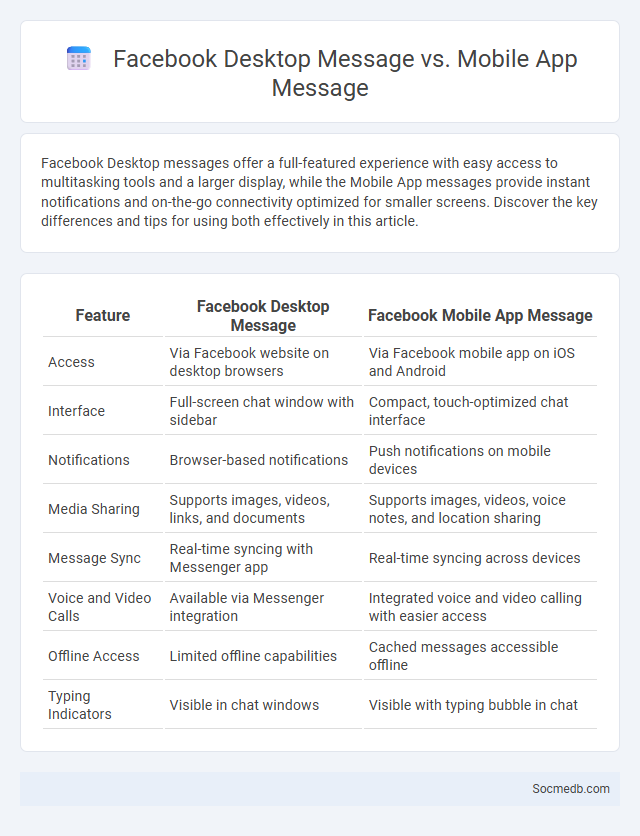
Photo illustration: Facebook Desktop Message vs Mobile App Message
Facebook Desktop messages offer a full-featured experience with easy access to multitasking tools and a larger display, while the Mobile App messages provide instant notifications and on-the-go connectivity optimized for smaller screens. Discover the key differences and tips for using both effectively in this article.
Table of Comparison
| Feature | Facebook Desktop Message | Facebook Mobile App Message |
|---|---|---|
| Access | Via Facebook website on desktop browsers | Via Facebook mobile app on iOS and Android |
| Interface | Full-screen chat window with sidebar | Compact, touch-optimized chat interface |
| Notifications | Browser-based notifications | Push notifications on mobile devices |
| Media Sharing | Supports images, videos, links, and documents | Supports images, videos, voice notes, and location sharing |
| Message Sync | Real-time syncing with Messenger app | Real-time syncing across devices |
| Voice and Video Calls | Available via Messenger integration | Integrated voice and video calling with easier access |
| Offline Access | Limited offline capabilities | Cached messages accessible offline |
| Typing Indicators | Visible in chat windows | Visible with typing bubble in chat |
Introduction to Facebook Messaging Platforms
Facebook Messaging Platforms offer an integrated communication system enabling businesses to connect with customers through Messenger, Instagram Direct, and WhatsApp. These platforms support automated chatbots, allowing personalized interactions and efficient customer service. Leveraging Facebook Messaging APIs helps streamline messaging workflows and enhance user engagement across multiple social channels.
Overview: Desktop Message vs Mobile App vs Direct Message
Desktop messaging platforms offer enhanced functionality for social media users, including larger screen interfaces and integration with other productivity tools. Mobile apps provide on-the-go accessibility, push notifications, and optimized touch interactions, making them ideal for instant communication and real-time updates. Direct messages on both desktop and mobile apps ensure private, personalized conversations, supporting multimedia sharing and end-to-end encryption for secure communication.
User Interface Comparison
Social media platforms exhibit distinct user interface designs that prioritize user engagement and navigation efficiency. Facebook offers a comprehensive layout with multiple feature access points, while Instagram emphasizes a minimalist interface focused on visual content and easy story interaction. Twitter combines real-time updates with a streamlined tweet-centric feed, optimizing quick content consumption and interaction.
Accessibility and Convenience
Social media platforms prioritize accessibility by offering user-friendly interfaces and compatibility across devices, ensuring seamless interaction for individuals with diverse needs. Your ability to connect instantly and share content worldwide enhances convenience, enabling real-time communication without geographical barriers. Features like voice commands, screen readers, and customizable settings further improve usability for users with disabilities.
Features and Functionalities
Social media platforms offer features such as real-time messaging, multimedia sharing, live streaming, and customizable profiles that enhance user engagement and connectivity. Advanced functionalities include algorithm-driven content recommendations, hashtag indexing for topic discovery, and integrated analytics tools for tracking user interaction and reach. Platforms also support community building through groups, events, and direct communication channels, facilitating seamless social networking and content dissemination.
Notification Systems and Real-Time Sync
Notification systems in social media platforms enhance user engagement by delivering timely alerts about messages, likes, comments, and friend requests. Real-time synchronization ensures that updates across devices remain consistent, providing seamless user experiences without delays or data conflicts. Advanced technologies like WebSocket and push notifications enable these features to maintain instant communication and dynamic content updates.
Privacy and Security Differences
Your social media privacy involves controlling who can see your personal data and posts, while security focuses on protecting your accounts from unauthorized access and cyber threats. Privacy settings regulate visibility, such as profile information and friend lists, whereas security measures include strong passwords, two-factor authentication, and regular monitoring for suspicious activity. Understanding the distinction helps you safeguard your identity and data from breaches and misuse.
Performance and Speed Analysis
Social media platforms rely heavily on performance and speed analysis to optimize user experience and engagement by reducing load times and minimizing latency. Real-time data processing and content delivery networks (CDNs) are critical for ensuring seamless video streaming, instant notifications, and rapid content updates. Advanced analytics tools track response times and server performance to identify bottlenecks, enabling continuous improvement in platform responsiveness through efficient resource allocation and caching strategies.
Cross-Platform Integration
Cross-platform integration allows you to seamlessly manage multiple social media accounts from a single dashboard, enhancing your content distribution and audience engagement. By synchronizing posts, analytics, and messaging across platforms such as Facebook, Instagram, Twitter, and LinkedIn, you maximize reach and maintain brand consistency. Effective cross-platform strategies optimize workflow efficiency and provide comprehensive insights into user behavior, improving your overall social media performance.
Choosing the Best Facebook Messaging Option
Selecting the best Facebook messaging option depends on the specific needs of communication, whether it's Facebook Messenger, Facebook Business Suite, or Messenger API. Facebook Messenger offers user-friendly direct messaging for personal and small-business use, while Facebook Business Suite integrates messaging across Facebook and Instagram for centralized management. For developers and larger enterprises, Messenger API enables custom integration and automation, enhancing customer interaction and scalability.
 socmedb.com
socmedb.com